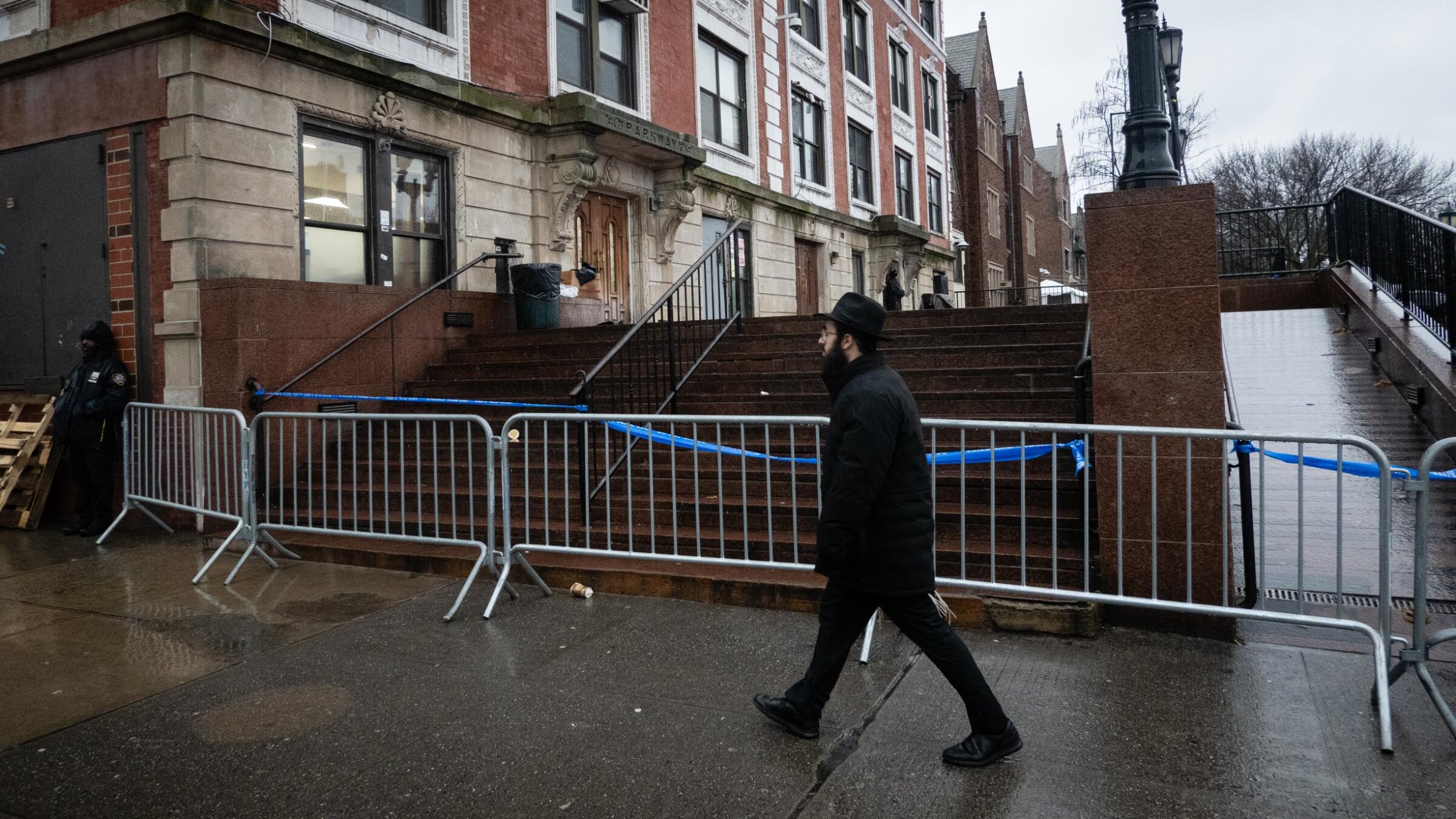NYC investigators find 60-foot underground tunnel beneath building next to Chabad headquarters
Investigators uncovered “a single linear underground tunnel” that was approximately 8 feet wide and 5 feet tall and had been illegally excavated

Police block the entrance to the main synagogue of Chabad headquarters due to safety concerns, Jan. 9, 2024. (Luke Tress)
(New York Jewish Week) — New York City’s Department of Buildings said investigators found a 60-foot long tunnel underneath a building adjacent to the Chabad headquarters in Crown Heights, Brooklyn.
Drama surrounding a tunnel into the well known building at 770 Eastern Parkway had drawn international attention after bedlam broke out at the complex’s synagogue on Monday. A group of men had tried to tunnel into the synagogue in an effort to expand the headquarters, and when authorities attempted to repair holes they had breached, the men tore into the synagogue’s walls.
Nine people were arrested and three cited for disorderly conduct during the commotion, which also gave rise to antisemitic conspiracies online and brought rifts within Chabad to the fore. The headquarters at 770, a building that has taken on symbolic significance for the Hasidic movement’s global network of emissaries, has been closed since Monday afternoon.
But until now, the extent and nature of the tunnel was unknown. Investigators uncovered “a single linear underground tunnel” that was approximately 8 feet wide and 5 feet tall and had been illegally excavated, the department told the New York Jewish Week on Wednesday.
The 60-foot tunnel, approximately the length of a bowling alley, was in the basement of a single-story building behind the Chabad headquarters’ main synagogue, where Monday’s fracas took place. The department has been investigating it since Tuesday morning.
Those who dug the tunnel had created several openings in the basement walls of the single-story building. It wasn’t immediately clear how much of the tunnel had been excavated from the ground, and how much was formed by making openings in existing rooms.
“The safety of our fellow New Yorkers is our highest priority,” the department said in a statement. “We will continue to monitor the progress of this emergency stabilization work, and if necessary, we are ready to take additional actions that may be required in the interest of public safety.”
The tunnel had rudimentary supports in place and was constructed without approval or permits. City engineers said the excavation had undermined the building above it, as well as another building on Kingston Ave., causing structural stability issues. The Department of Buildings issued partial vacate orders for both buildings due to safety concerns.
The department said other neighboring structures were unaffected and could be reoccupied, apparently meaning that the synagogue itself was not impacted.
The city instructed the owners of the properties to hire an engineer to stabilize the excavation and fill in the tunnel where necessary. The owners had already employed an architect, engineer and contractor on site who were preparing to do the emergency work, the department said.
Reports of the tunnel first surfaced last month. After Monday’s fracas, police were summoned to the site and arrested cited individuals for charges including criminal mischief, reckless endangerment, disorderly conduct and attempted hate crimes, a police spokesperson told the New York Jewish Week. There was no further information on the nature of the alleged hate crimes. Video from the scene showed young men shouting, arguing with police, being handcuffed and removed from the building.
Chabad spokespeople and students who were at the scene described those responsible for the tunnel as a fringe group within the movement whose activities were opposed by the majority of its adherents. Chabad leaders had condemned the incident and expressed anguish over the synagogue’s closure.
Reached for comment, a Chabad spokesperson said a statement would be issued soon.
Students who were at the scene told the New York Jewish Week that the tunnel had been part of an effort to expand the synagogue. Some members of Chabad believe that the movement’s late leader, Rabbi Menachem Mendel Schneerson, said they had a duty to expand the building.
Schneerson’s office was located at 770, and and it was the home of his father-in-law and predecessor, Rabbi Yosef Yitzchak Schneerson. It is now a place of prayer, study and other Chabad activities.
Schneerson died in 1994, leading the movement without a living leader, and the headquarters complex has been the subject of a years-long legal battle over ownership between rival Chabad institutions. Disputes over where the site should be expanded, and how it should be done, have come to the fore in the wake of the incident.
Baseless antisemitic conspiracies also spread online, including false claims that a tunnel network under the synagogue was used for trafficking children, echoing centuries-old antisemitic blood libels. The tunnel was empty except for dirt, tools and debris, the Department of Buildings said.
This article originally appeared on JTA.org.
A message from our CEO & publisher Rachel Fishman Feddersen
I hope you appreciated this article. Before you go, I’d like to ask you to please support the Forward’s award-winning, nonprofit journalism during this critical time.
We’ve set a goal to raise $260,000 by December 31. That’s an ambitious goal, but one that will give us the resources we need to invest in the high quality news, opinion, analysis and cultural coverage that isn’t available anywhere else.
If you feel inspired to make an impact, now is the time to give something back. Join us as a member at your most generous level.
— Rachel Fishman Feddersen, Publisher and CEO